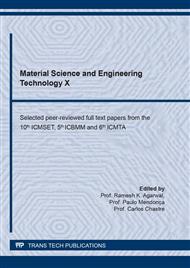p.352
p.358
p.367
p.377
p.383
p.389
p.397
p.405
p.410
The Study Influence of Sugarcane Leaves Fibers Ratio on Compressive Strength of Fire Clay Bricks
Abstract:
This research aimed to reuse the waste of sugar cane leaves to improve the properties of clay bricks by using Design of Experiment (DOE) full factorial designs. There are 3 factors in this process, i.e., the sugarcane leaf fiber content, firing temperature and the length of sugarcane leaves fibers. The results showed that the addition of sugarcane leaf fiber content and length of sugarcane leaves fibers increased the porosity the clay bricks along with decreasing the density and compressive strength. The different temperatures did not affect the compressive strength of clay bricks. The maximum porosity values were found with the additional 7.5%wt of sugarcane leaf fiber content and 2.5 to 2.8 mm of length sugarcane leaves fibers. By adding 2.5%wt of sugarcane leaf fiber content and 1.0 to 1.3 mm of length sugarcane leaves fibers, the brick samples had the compressive strength of 19.97 MPa, which is required by ASTM C67-11 and Thai industrial standard of clay bricks TIS. 77 – 2545.
Info:
Periodical:
Pages:
383-388
Citation:
Online since:
February 2022
Authors:
Keywords:
Price:
Сopyright:
© 2022 Trans Tech Publications Ltd. All Rights Reserved
Share:
Citation:


